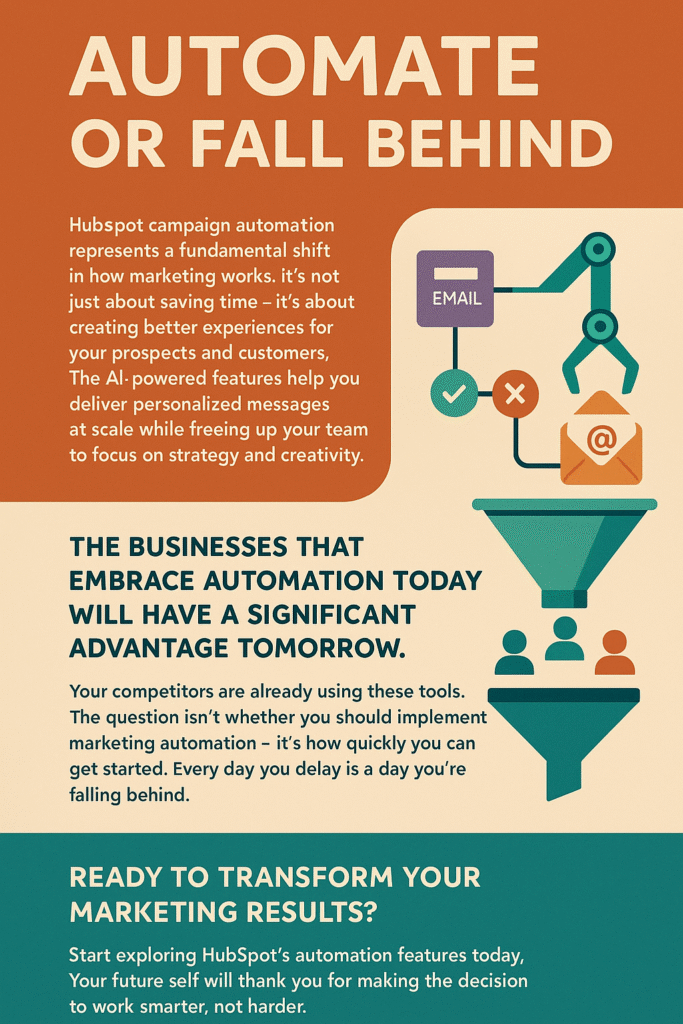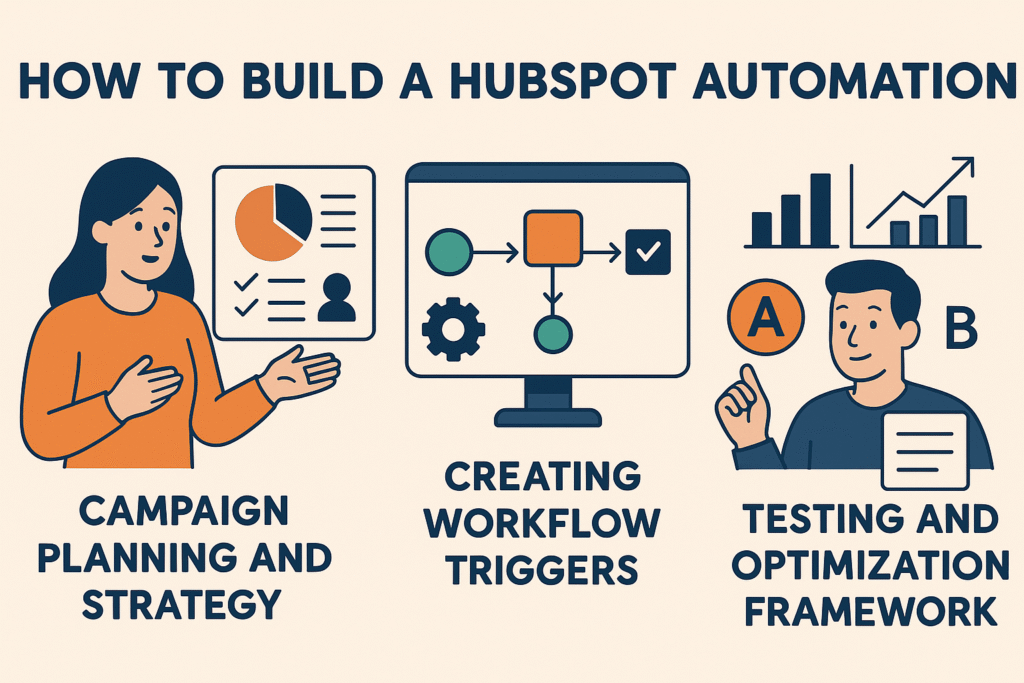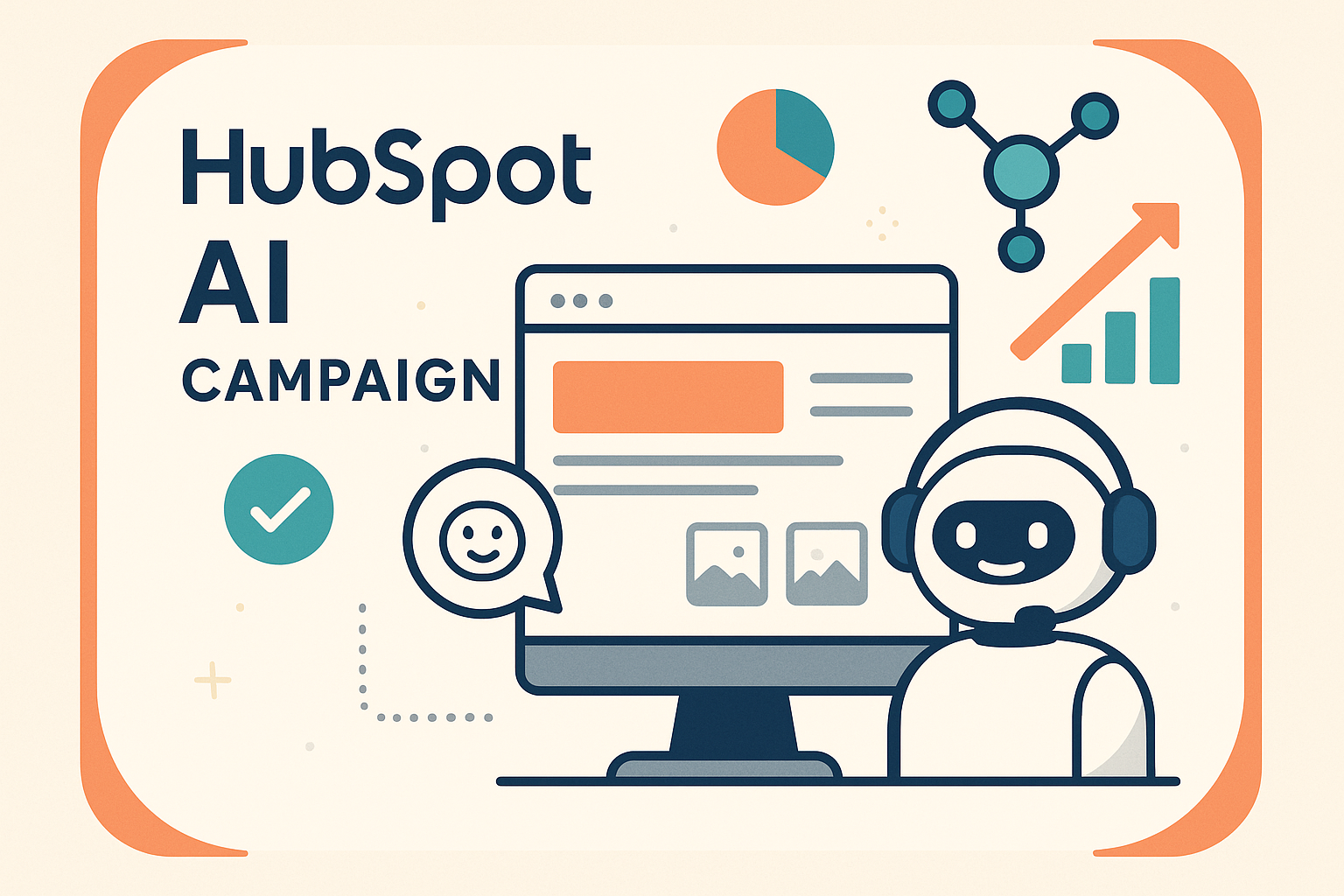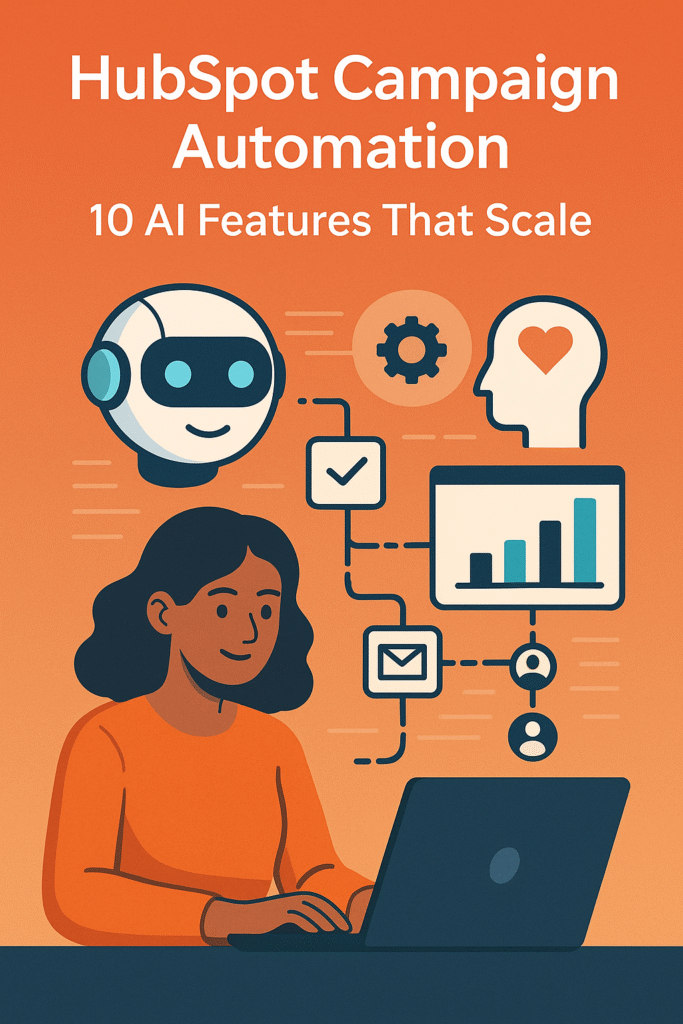Table of Contents
Struggling with repetitive marketing tasks while your competitors effortlessly generate leads? HubSpot campaign automation is your solution to transform manual work into smart, AI-powered workflows. Most marketers waste 60% of their time on routine tasks instead of strategy. This is where HubSpot campaign automation becomes your secret weapon to personalize, automate, and scale your marketing efforts.
Marketing automation isn’t just a buzzword anymore. It’s the difference between businesses that scale and those that struggle. With HubSpot’s AI-powered features, you can finally break free from manual work and create campaigns that run themselves while you sleep.

What Makes HubSpot Campaign Automation So Powerful?
HubSpot campaign automation combines artificial intelligence with smart workflow design. This powerful combination helps you deliver the right message to the right person at exactly the right time. Think of it as having a personal marketing assistant that never takes a break.
The platform uses machine learning to analyze your contacts’ behavior patterns. It then automatically adjusts your campaigns based on real-time data. This means your marketing becomes smarter with every interaction.
Unlike basic email tools, HubSpot’s automation goes beyond simple triggers. It creates complex, multi-channel experiences that feel personal to each contact. Your leads get relevant content while you focus on bigger picture strategies.
The Psychology Behind Effective Automation
Understanding human psychology is crucial for successful marketing automation. HubSpot’s AI taps into behavioral psychology principles to create campaigns that genuinely resonate with your audience.
The platform recognizes that people make decisions based on emotions first, then justify with logic. This is why HubSpot’s automation focuses on emotional triggers alongside data-driven insights. Your campaigns become more persuasive because they speak to both hearts and minds.
Timing psychology also plays a huge role. HubSpot analyzes when your contacts are most active and engaged. It automatically sends messages when people are most likely to open, read, and act. This isn’t just about time zones – it’s about individual behavior patterns.
Breaking Down Automation Complexity
Many marketers avoid automation because it seems overwhelming. HubSpot solves this by breaking complex processes into simple, manageable steps. You don’t need to understand every technical detail to create effective campaigns.
The platform uses visual workflows that look like flowcharts. Each step represents a decision point or action. You can see exactly how your campaign will behave before you launch it. This transparency removes the mystery from automation.
HubSpot also provides templates for common marketing scenarios. Whether you’re nurturing leads, onboarding customers, or re-engaging dormant contacts, there’s a proven template to start with. You can customize these templates to match your specific needs.
The AI Revolution in Marketing Automation
Artificial intelligence has changed everything about how we approach marketing. Gone are the days when you had to guess what your audience wants. AI content generation now helps create personalized messages at scale, and AI-powered advertising campaigns are revolutionizing how businesses reach their target audiences.
HubSpot’s comprehensive AI features analyze thousands of data points about your contacts. It looks at their website behavior, email engagement, social media activity, and purchase history. This creates a complete picture of each lead’s journey.
The system then uses this information to make smart decisions about your campaigns. It can predict which leads are most likely to convert and automatically nurture them with targeted content. This level of personalization was impossible just a few years ago.
Machine Learning That Gets Smarter Over Time
HubSpot’s AI doesn’t just analyze data – it learns from it. Every email open, click, and conversion teaches the system something new about your audience. This continuous learning process makes your campaigns more effective over time.
The machine learning algorithms identify patterns that humans might miss. Maybe your audience responds better to questions in subject lines. Perhaps they prefer shorter emails on Mondays but longer content on Fridays. The AI discovers these insights automatically.
This learning happens across all your campaigns simultaneously. Insights from one workflow can improve performance in completely different campaigns. Your entire marketing operation becomes more intelligent as you use the platform more.
Predictive Analytics for Better Decision Making
One of HubSpot’s most powerful features is its predictive analytics. Instead of just reporting what happened, it predicts what will happen next. This helps you make proactive decisions rather than reactive ones.
The system can predict which leads are most likely to convert, which customers might churn, and which content will perform best. These predictions are based on historical data from your account and millions of other HubSpot users.
Predictive analytics also helps with budget allocation. You can see which campaigns are likely to generate the highest ROI before you invest heavily in them. This reduces waste and maximizes your marketing budget effectiveness.
Setting Up Your First Automated Campaign
Getting started with HubSpot automation doesn’t require a computer science degree. The platform makes it surprisingly easy to create sophisticated campaigns. Here’s how to build your first automation from scratch.
First, you’ll define your campaign goals. Are you trying to nurture new leads? Re-engage dormant contacts? Drive sales for a specific product? Your goals will shape everything else. Be specific about what success looks like for this campaign.
Next, you’ll create your workflow triggers. These are the actions that start your automation. Common triggers include form submissions, email opens, website visits, or specific behaviors. The key is choosing triggers that indicate genuine interest rather than casual browsing.
Then comes the fun part – designing your campaign flow. HubSpot’s visual workflow builder lets you map out complex sequences without writing code. You can create different paths based on how contacts respond to your messages.
Campaign Planning and Strategy
Before jumping into HubSpot’s workflow builder, spend time planning your campaign strategy. The best automation starts with clear thinking about your audience and their needs.
Create detailed buyer personas for your target audience. What challenges do they face? What information do they need to make decisions? How do they prefer to receive information? These insights will guide your automation design.
Map out your customer journey from first contact to final purchase. Identify the key decision points where automation can provide value. Maybe prospects need case studies after downloading a whitepaper. Or perhaps they need pricing information after viewing multiple product pages.
Consider the emotional journey alongside the logical one. People don’t just need information – they need reassurance, excitement, and confidence. Your automation should address these emotional needs throughout the process.
Testing and Optimization Framework
Even the best-planned campaigns need testing and optimization. HubSpot provides tools to test different versions of your messages and workflows. This A/B testing capability is crucial for maximizing your results.
Start with simple tests like subject lines and send times. These small changes can have big impacts on your open rates and engagement. Once you understand what works, you can test more complex elements like content length and call-to-action placement.
Don’t test everything at once. Focus on one variable at a time so you can clearly see what’s causing changes in performance. This methodical approach helps you build a knowledge base of what works for your specific audience.
Set up clear success metrics before launching your tests. Are you optimizing for open rates, click-through rates, or conversions? Different goals require different testing approaches. Make sure your tests run long enough to gather statistically significant data.

Smart Content Creation with AI
One of the biggest challenges in marketing is creating enough content to keep your campaigns fresh. HubSpot’s AI content tools solve this problem by helping you generate ideas and copy faster than ever before.
The AI analyzes your existing high-performing content to understand what resonates with your audience. It then suggests topics, headlines, and even full email drafts that match your brand voice. This doesn’t replace human creativity – it amplifies it.
You can also use AI to optimize your content for different segments. The same core message can be automatically adapted for different industries, company sizes, or buyer personas. This level of customization used to require huge marketing teams.
Content Personalization at Scale
HubSpot’s AI takes personalization far beyond inserting first names into emails. It can personalize entire content experiences based on dozens of data points about each contact.
The system might show different case studies to prospects in different industries. A healthcare company might see testimonials from other healthcare organizations, while a tech startup sees success stories from similar companies. This relevance increases engagement and conversion rates.
Dynamic content blocks change automatically based on who’s viewing them. Your landing pages, emails, and even website content can adapt in real-time. This creates a truly personalized experience for each visitor without requiring manual work from your team.
Content scoring algorithms help identify which pieces of content are most effective for different stages of the buyer journey. The AI tracks how content performs across different segments and suggests the best content for each situation.
AI-Powered Content Optimization
HubSpot’s AI doesn’t just create content – it optimizes it for maximum impact. The system analyzes millions of successful marketing messages to identify patterns that drive engagement.
Subject line optimization uses natural language processing to suggest improvements. The AI might recommend shorter subject lines for mobile users or question-based headlines for higher open rates. These suggestions are based on real performance data from similar campaigns.
Content timing optimization determines when each piece of content should be delivered. The AI considers factors like industry, company size, and individual behavior patterns. This ensures your content reaches people when they’re most likely to engage with it.
Sentiment analysis helps ensure your content maintains the right tone throughout the customer journey. The AI can detect if your messaging is too aggressive or too passive and suggest adjustments to match your audience’s preferences.
Lead Scoring and Qualification Automation
Not all leads are created equal. HubSpot’s AI-powered lead scoring helps you identify your hottest prospects automatically. The system assigns scores based on dozens of factors you might never think to track manually.
The AI considers both explicit data (job title, company size) and implicit signals (email engagement, website behavior). It learns from your past conversions to predict which new leads are most likely to become customers.
This automated qualification process ensures your sales team spends time on the right prospects. Instead of chasing cold leads, they can focus on contacts who are genuinely ready to buy. This dramatically improves your sales optimization efforts.
Advanced Scoring Methodologies
HubSpot’s lead scoring goes beyond simple point systems. The AI uses complex algorithms that weigh different factors based on their actual impact on conversion rates. This creates more accurate scores than traditional manual scoring methods.
Behavioral scoring tracks how prospects interact with your content and website. Someone who downloads multiple resources and visits your pricing page multiple times gets a higher score than someone who only opens emails occasionally. The AI understands these behavior patterns and scores accordingly.
Demographic scoring considers factors like company size, industry, and job title. But it doesn’t use generic assumptions. Instead, it analyzes your specific customer data to understand which demographics are most likely to convert for your business.
Engagement scoring measures how actively prospects interact with your marketing. This includes email opens, clicks, social media engagement, and website visits. The AI creates a comprehensive engagement profile for each lead.
Dynamic Lead Routing
Once leads are scored, HubSpot can automatically route them to the right sales representatives. This routing can be based on score, geography, industry, or any other criteria you define.
High-scoring leads can be immediately assigned to your best sales reps, while lower-scoring leads continue through nurture campaigns. This ensures your top performers handle your hottest prospects while automation continues to warm up other leads.
The system can also balance lead distribution among your sales team. If one rep is overloaded while another has capacity, the AI can adjust routing accordingly. This prevents bottlenecks and ensures faster response times.
Geographic routing ensures leads connect with local sales reps who understand regional markets. The AI can consider time zones, languages, and local business practices when making routing decisions.
Multi-Channel Campaign Orchestration
Modern buyers don’t follow linear paths. They might discover you on social media, visit your website, download a resource, and then go quiet for months. HubSpot automation helps you stay connected across all these touchpoints.
The platform can automatically coordinate your email, social media, and even direct mail campaigns. If someone downloads an ebook, they might get a follow-up email, see a related social ad, and receive a personalized direct mail piece. All without you lifting a finger.
This multi-channel approach increases your chances of staying top-of-mind. Different people prefer different communication channels, and automation ensures you’re reaching them where they’re most comfortable.
Advanced Personalization Techniques
Generic marketing messages get ignored. HubSpot’s AI helps you create messages that feel like they were written specifically for each contact. This goes far beyond using someone’s first name in an email.
The system can personalize content based on industry, company size, recent website activity, or past purchases. It might show different case studies to different segments or adjust your messaging based on where someone is in the buying process.
Dynamic content takes this even further. Your emails and landing pages can automatically change based on who’s viewing them. A small business owner might see different pricing options than an enterprise buyer, all from the same campaign.
Measuring and Optimizing Your Automation
The best part about HubSpot campaign automation is the wealth of data it provides. You can see exactly how your campaigns perform at every step of the journey. This transparency helps you make data-driven improvements.
The platform tracks everything from email open rates to conversion paths. You can see which messages work best, which timing gets the most engagement, and which segments are most responsive. This information becomes the foundation for optimizing future campaigns.
HubSpot’s AI also provides recommendations for improving your campaigns. It might suggest different send times, subject lines, or content topics based on your performance data. These suggestions come from analyzing millions of successful campaigns across the platform.
Integration with Sales and Service Teams
Marketing automation works best when it connects with your entire customer journey. HubSpot’s unified platform ensures your marketing, sales, and service teams are all working from the same playbook.
When a lead reaches a certain score, they’re automatically assigned to a sales rep. The rep gets a complete history of the lead’s interactions with your company. This context helps them have more meaningful conversations and close deals faster.
Service teams can also use automation to improve customer experience. They can automatically send onboarding sequences, satisfaction surveys, or renewal reminders. This ensures customers stay engaged long after their initial purchase.
Common Automation Mistakes to Avoid
Even the best automation platform can’t fix poor strategy. Here are the most common mistakes that can hurt your results.
Over-automation is a real problem. Not every interaction needs to be automated. Sometimes a personal touch is exactly what a lead needs. The key is finding the right balance between efficiency and humanity.
Ignoring data quality will sabotage your efforts. Your automation is only as good as the data it’s based on. Make sure your contact information is clean and up-to-date. Bad data leads to irrelevant messages and frustrated prospects.
Forgetting to test your workflows can lead to embarrassing mistakes. Always test your automations before launching them. Send test emails to yourself and walk through the entire experience from a contact’s perspective.
Future-Proofing Your Marketing Strategy
Marketing automation technology evolves quickly. What works today might not work tomorrow. HubSpot’s platform is designed to grow with these changes, but you need to stay informed about new features and best practices.
The integration of AI and machine learning will only get more sophisticated. Soon, automation platforms will be able to predict customer behavior with even greater accuracy. They’ll automatically adjust campaigns in real-time based on market conditions and individual preferences.
Voice technology and conversational AI are also changing how we interact with customers. HubSpot continues to innovate in these areas, ensuring your automation strategy stays current with emerging trends.
Getting Started with HubSpot Automation Today
The best time to start with marketing automation was yesterday. The second best time is now. Every day you wait is another day your competitors are building stronger relationships with your potential customers.
Start small with simple workflows. Maybe begin with a welcome series for new subscribers or a re-engagement campaign for dormant contacts. As you get comfortable with the platform, you can build more complex sequences.
Don’t try to automate everything at once. Focus on your biggest pain points first. What tasks take up most of your time? What processes could benefit from more consistency? Start there and expand gradually.

Conclusion
HubSpot campaign automation represents a fundamental shift in how marketing works. It’s not just about saving time – it’s about creating better experiences for your prospects and customers. The AI-powered features help you deliver personalized messages at scale while freeing up your team to focus on strategy and creativity.
The businesses that embrace automation today will have a significant advantage tomorrow. They’ll be able to nurture more leads, close more deals, and retain more customers with less effort. Meanwhile, companies that stick to manual processes will struggle to keep up.
Your competitors are already using these tools. The question isn’t whether you should implement marketing automation – it’s how quickly you can get started. Every day you delay is a day you’re falling behind.
Ready to transform your marketing results? Start exploring HubSpot’s automation features today. Your future self will thank you for making the decision to work smarter, not harder.
Frequently Asked Questions
Q: How long does it take to set up HubSpot campaign automation?
A: Basic workflows can be set up in under an hour. More complex campaigns might take a few days to plan and implement properly. The key is starting simple and building complexity over time.
Q: Do I need technical skills to use HubSpot automation?
A: No programming knowledge is required. HubSpot’s visual workflow builder makes it easy to create sophisticated campaigns using drag-and-drop tools. However, understanding your audience and marketing strategy is essential.
Q: Can HubSpot automation work for small businesses?
A: Absolutely. HubSpot offers plans scaled for businesses of all sizes. Small businesses often see the biggest impact because automation helps them compete with larger companies without needing huge marketing teams.
Q: How much does HubSpot campaign automation cost?
A: HubSpot offers free tools with basic automation features. Paid plans start at $45/month for more advanced features. The cost depends on your contact database size and the features you need.
Q: Will automation make my marketing feel impersonal?
A: When done correctly, automation makes your marketing more personal, not less. AI helps you deliver relevant messages to the right people at the right time. The key is maintaining a human voice in your automated messages.
Q: How do I measure the success of my automated campaigns?
A: HubSpot provides detailed analytics showing open rates, click-through rates, conversions, and ROI. You can track the entire customer journey from first contact to closed deal. Focus on metrics that align with your business goals.
Q: Can I integrate HubSpot automation with other tools?
A: Yes, HubSpot integrates with hundreds of popular business tools including CRM systems, social media platforms, and e-commerce solutions. This ensures your automation works seamlessly with your existing tech stack.
